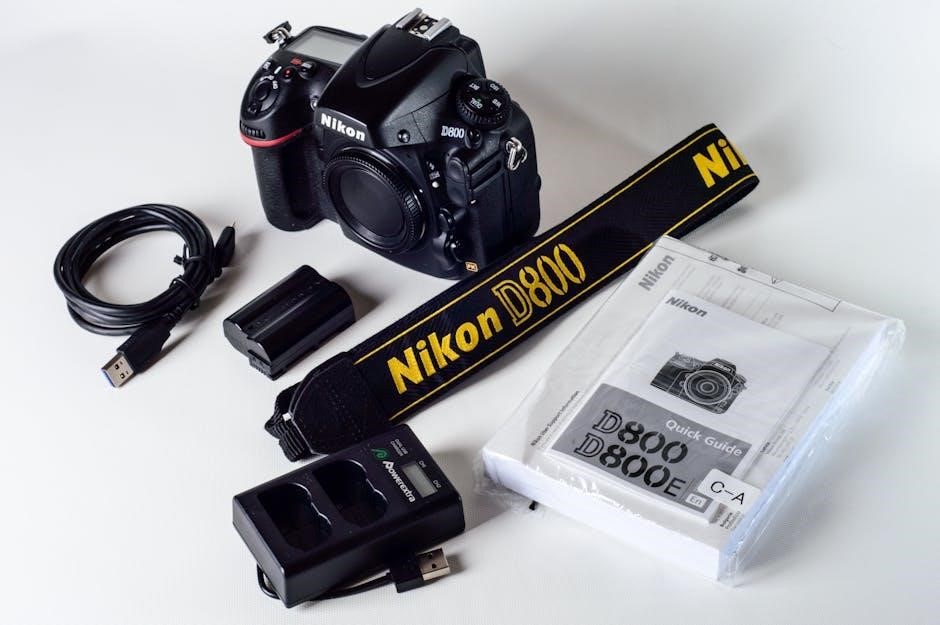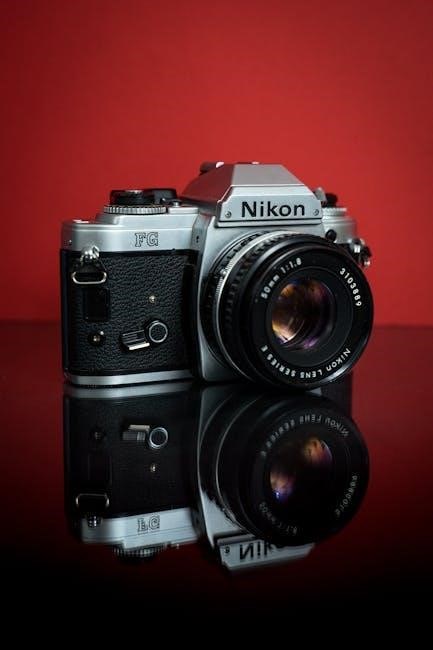nikon fg instruction manual

The Nikon FG instruction manual is your guide to mastering this iconic 35mm SLR camera. Learn about its features, shooting modes, and exposure control to unlock its full potential.
Overview of the Nikon FG Camera
The Nikon FG is a compact and lightweight 35mm SLR camera designed for versatility and ease of use. It offers advanced features like exposure compensation, aperture-priority mode, and full manual control, making it ideal for both beginners and experienced photographers. The camera supports a wide range of interchangeable Nikon lenses and accessories, enhancing its adaptability for various shooting scenarios. With its intuitive design and robust functionality, the Nikon FG provides a seamless photography experience, allowing users to capture high-quality images with precision and creativity. This overview highlights the key aspects of the camera, setting the stage for a deeper exploration of its capabilities.
Importance of the Instruction Manual
The Nikon FG instruction manual is essential for understanding and maximizing the camera’s capabilities. It provides detailed guidance on basic operations, advanced features, and troubleshooting, ensuring users can navigate the camera confidently. Whether you’re a novice or an experienced photographer, the manual offers insights into optimizing settings for various shooting conditions. It also covers maintenance tips and common issues, helping to extend the camera’s lifespan. By studying the manual, you can unlock the full potential of the Nikon FG, leveraging its interchangeable lenses and accessories effectively. This comprehensive guide is indispensable for anyone aiming to enhance their photography skills with this iconic camera.

Camera Features and Specifications
The Nikon FG is a compact, lightweight 35mm SLR offering Program, Aperture-Priority, and Manual modes. It features advanced controls like exposure compensation and TTL flash measurement for precise photography.
Key Components of the Nikon FG
The Nikon FG features a durable, compact body with a built-in flash shoe and a clear viewfinder for precise composition. Its interchangeable lens system supports over 60 Nikon lenses, offering versatility. The camera includes a manual focus ring, aperture ring, and a shutter speed dial for full control. The ASA/ISO dial allows film speed adjustment, while the battery compartment powers the camera’s electronic functions. Additional components include the exposure compensation dial, self-timer, and a tripod socket for stability. The FG also supports TTL (Through-The-Lens) flash measurement for accurate flash photography. These components combine to make the Nikon FG a versatile and powerful tool for both amateur and professional photographers.
Shooting Modes: Program, Aperture-Priority, and Manual
The Nikon FG offers three versatile shooting modes to suit various photography needs. Program mode automatically sets both aperture and shutter speed for quick, hassle-free shooting. Aperture-Priority mode allows manual control over the aperture, with the camera adjusting the shutter speed accordingly. This mode is ideal for controlling depth of field. Manual mode grants full control over both aperture and shutter speed, enabling precise exposure adjustments. These modes cater to photographers of all skill levels, providing flexibility and creative control. The FG’s intuitive design ensures seamless switching between modes, making it adaptable to different lighting conditions and artistic preferences. This versatility enhances the overall shooting experience, offering both convenience and precision in capturing memorable images.

Basic Camera Operations
Mastering basic operations is essential for optimal use of the Nikon FG. This section covers fundamental functions like loading film, battery installation, and mounting lenses, ensuring smooth operation and precise control over your photography experience.
Loading Film and Battery Installation
Loading film and installing batteries are crucial first steps in preparing your Nikon FG for use. Begin by ensuring the camera is in a safe, static-free environment. Open the film door by pulling the rewind knob upwards. Carefully insert the film cartridge, aligning it with the spool. Gently close the door and advance the film until the start mark aligns with the red index. Battery installation involves inserting two LR44 or SR44 cells into the battery chamber, located on the bottom plate. Replace the chamber cover securely. Always use fresh batteries for optimal performance and reliability. Follow these steps to ensure your camera is ready for shooting.
Mounting Lenses and Accessories
Mounting lenses and accessories on the Nikon FG is straightforward. Align the lens with the camera’s bayonet mount, ensuring the red dots on both the lens and camera align. Rotate the lens clockwise until it clicks securely into place. For accessories like motor drives or data backs, slide them onto the camera’s base and ensure they lock firmly. Always use Nikon System-compatible accessories for optimal performance. Avoid using unauthorized accessories to prevent damage or functional issues. Refer to the manual or manufacturer guidelines for specific compatibility details. Properly mounted lenses and accessories enhance your shooting experience and ensure reliable operation of the Nikon FG.

Exposure Modes and Settings
The Nikon FG offers Program, Aperture-Priority, and Manual modes, providing flexibility for photographers to control exposure settings according to their creative needs and lighting conditions.
Program Mode Operation
In Program Mode, the Nikon FG automatically selects both aperture and shutter speed to ensure optimal exposure. This mode is ideal for beginners or quick shooting situations where manual adjustments are unnecessary. The camera uses a built-in light meter to evaluate the scene and set the exposure accordingly. By rotating the shutter speed dial to the “P” position, users can rely on the FG’s advanced automation. However, photographers can still influence the exposure by using the exposure compensation dial, allowing for subtle adjustments to brighten or darken the image as needed. This balance of automation and control makes Program Mode versatile and user-friendly.
Aperture-Priority Mode
Aperture-Priority Mode on the Nikon FG offers photographers precise control over depth of field by allowing manual selection of the aperture. The camera then automatically adjusts the shutter speed to achieve the optimal exposure. This mode is particularly useful for portraits, where a wide aperture (small f-stop number) can blur the background, or for landscapes, where a narrow aperture (large f-stop number) ensures sharpness throughout. By setting the desired aperture using the lens aperture ring, users can creatively influence the image’s aesthetic while relying on the FG’s metering system for accurate exposures. This mode strikes a balance between creative control and technical automation.
Manual Control of Shutter Speeds
Manual Control of Shutter Speeds on the Nikon FG provides photographers with full creative authority over exposure settings. By rotating the shutter speed selector dial, users can manually set speeds ranging from 1 second to 1/1000th of a second, as well as Bulb (B) and Time (T) modes for extended exposures. This mode is ideal for advanced photographers who want precise control over lighting and motion effects. When in manual mode, the FG requires users to adjust both aperture and shutter speed to achieve proper exposure, offering unparalleled flexibility for artistic expression and technical experimentation. This feature underscores the FG’s suitability for professional and enthusiast photographers alike.

Focusing and Metering
The Nikon FG offers precise focusing and metering controls, ensuring sharp images and accurate exposures. Its manual focus and advanced metering modes enhance creative photography.
Autofocus and Manual Focus Features
The Nikon FG combines intuitive autofocus and manual focus capabilities, providing photographers with flexibility. Autofocus ensures quick and precise subject tracking, while manual focus allows for fine-tuned adjustments. This dual system is particularly useful in varying lighting conditions and compositions, enabling shooters to maintain control over their creative vision. The camera’s manual focus ring offers smooth operation, making it easy to adjust focus without distraction. Additionally, the FG’s viewfinder provides clear focus confirmation, helping users achieve sharp images consistently. These features make the Nikon FG adaptable to both fast-paced and deliberate shooting styles, catering to a wide range of photographic needs and preferences.
Understanding Metering Modes
The Nikon FG offers two primary metering modes: center-weighted and spot metering. Center-weighted metering averages light across the entire frame, with emphasis on the central area, ideal for balanced exposures. Spot metering measures light from a specific spot, useful for high-contrast scenes or precise subject illumination. The camera’s TTL (Through-The-Lens) metering system ensures accurate readings, adapting to the mounted lens’s focal length and aperture. This system integrates seamlessly with the FG’s advanced features, such as flash photography, to deliver consistent results. Understanding these modes allows photographers to achieve optimal exposures in various lighting conditions, enhancing creative control and image quality.

Exposure Compensation and Flash
The Nikon FG features an exposure compensation dial and flash compatibility with TTL measurement for precise control over lighting. Adjust exposures and use flash seamlessly for optimal results.
Using the Exposure Compensation Dial
The exposure compensation dial on the Nikon FG allows precise control over your images’ brightness. By adjusting this dial, you can compensate for challenging lighting conditions, ensuring your photos are perfectly exposed. Whether you’re shooting in bright sunlight or low-light environments, the dial provides easy access to adjust exposure settings. This feature is particularly useful for achieving the desired effect in various scenarios, such as backlit subjects or high-contrast scenes. Refer to the manual for detailed instructions on how to effectively use this feature to enhance your photography. Proper use of the dial ensures that your images retain the right balance of light and shadow, making every shot a professional one. Always remember to reset the dial after use to avoid unintended exposure changes in subsequent shots. This simple yet powerful tool is a testament to the Nikon FG’s versatility and user-friendly design. By mastering the exposure compensation dial, you can take full control of your camera’s capabilities and produce stunning results consistently.
Flash Photography and TTL Measurement
Flash photography with the Nikon FG is enhanced by its compatibility with Nikon’s TTL (Through-The-Lens) flash system, ensuring accurate light measurement. The camera supports external flash units like the SB-18, which integrate seamlessly for precise illumination. TTL measurement automatically adjusts flash output based on the scene, eliminating guesswork. For optimal results, position the flash to avoid harsh shadows and use the manual to understand synchronization settings. The LED on compatible flash units blinks to signal insufficient light or incorrect settings. By mastering TTL flash photography, you can achieve balanced and professional-looking images in various lighting conditions, making the Nikon FG a versatile tool for both casual and advanced photographers.

Advanced Features and Accessories

The Nikon FG supports motor drives and data backs, enhancing workflow efficiency. Its compatibility with Nikon’s interchangeable lenses expands creative possibilities, making it a versatile system for photographers.
Motor Drive and Data Back Compatibility
The Nikon FG seamlessly integrates with the Motor Drive MD-E, enabling automatic film advance and rewind. This accessory boosts shooting efficiency, especially in fast-paced environments. Additionally, the FG supports Nikon’s Data Back, which records exposure information like date, time, and shooting mode directly onto the film. This feature is invaluable for professional photographers and enthusiasts alike, offering precise documentation for post-shoot analysis. Compatibility with these accessories enhances the FG’s functionality, making it a robust tool for photographers seeking both convenience and control over their workflow.
Nikon System Interchangeable Lenses
The Nikon FG is part of the Nikon System, offering compatibility with a wide range of interchangeable Nikkor lenses. These lenses, renowned for their optical excellence, provide photographers with versatility across various focal lengths and types, including wide-angle, telephoto, and macro options. The FG’s lens mount supports AI and AIS lenses, ensuring precise aperture control and metering. This compatibility allows users to adapt their camera to different shooting scenarios, from portraits to landscapes. The Nikon System’s extensive lens lineup, combined with the FG’s advanced features, makes it a versatile tool for photographers seeking high-quality results. The manual details compatible lenses and their usage, enhancing the camera’s creative potential.

Maintenance and Troubleshooting
Regular cleaning of the viewfinder and lens ensures optimal performance; Check battery levels and replace them as needed. Troubleshoot common issues like improper film loading or shutter malfunctions by consulting the manual.

Camera Maintenance Tips
Proper maintenance ensures the Nikon FG operates efficiently. Regularly clean the viewfinder and lenses with a soft cloth to prevent dust buildup. Check the battery compartment for corrosion and replace batteries as needed. Store the camera in a dry, cool place to avoid moisture damage. For more thorough cleaning, use a brush to gently remove dust from internal components. Avoid extreme temperatures and handle the camera with care to maintain its durability. Refer to the manual for specific guidance on cleaning and storing your Nikon FG to prolong its lifespan and performance.
Common Issues and Solutions
The Nikon FG may experience issues like inaccurate metering or jammed film. For metering errors, ensure the battery is fresh. If film jams, gently rewind it. Faulty flash sync can be fixed by cleaning contacts. If the shutter sticks, try cleaning the camera or replacing the battery. For persistent problems, consult the manual or contact a professional. Regular maintenance helps prevent these issues, ensuring smooth operation. Troubleshooting guides in the manual provide detailed solutions for common faults, helping you resolve problems quickly and effectively, keeping your Nikon FG in optimal condition for photography sessions.
Mastering the Nikon FG requires understanding its features and modes. With practice, you’ll unlock its creative potential, ensuring every shot captures your vision perfectly. Refer to the manual for guidance and troubleshooting, optimizing your photography experience with this iconic camera.
Maximizing Your Nikon FG Experience
To fully maximize your Nikon FG experience, familiarize yourself with its advanced features, such as aperture-priority and manual modes, allowing precise control over your photography. Experiment with interchangeable lenses and accessories to expand your creative possibilities. Regular maintenance ensures optimal performance, while understanding metering modes enhances exposure accuracy. Practice without film to build confidence, and consult the manual for troubleshooting. By mastering these elements, you’ll unlock the full potential of the Nikon FG, capturing stunning images with ease and precision.